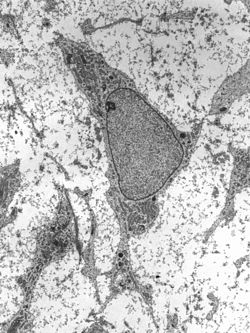Adult stem cell
| Adult stem cell | |
|---|---|

Transmission electron micrograph of an adult stem cell displaying typical ultrastructural characteristics.
|
|
| Details | |
| Identifiers | |
| Latin | Cellula praecursoria |
| Code | TH H1.00.01.0.00035 |
| TH | H1.00.01.0.00035 |
|
Anatomical terminology
[]
|
|
Adult stem cells are undifferentiated cells, found throughout the body after development, that multiply by cell division to replenish dying cells and regenerate damaged tissues. Also known as somatic stem cells (from Greek Σωματικóς, meaning of the body), they can be found in juvenile as well as adult animals and humans, unlike embryonic stem cells.
Scientific interest in adult stem cells is centered on their ability to divide or self-renew indefinitely, and generate all the cell types of the organ from which they originate, potentially regenerating the entire organ from a few cells. Unlike for embryonic stem cells, the use of human adult stem cells in research and therapy is not considered to be controversial, as they are derived from adult tissue samples rather than human embryos designated for scientific research. They have mainly been studied in humans and model organisms such as mice and rats.
A stem cell possesses two properties:
To ensure self-renewal, stem cells undergo two types of cell division (see Stem cell division and differentiation diagram). Symmetric division gives rise to two identical daughter cells, both endowed with stem cell properties, whereas asymmetric division produces only one stem cell and a progenitor cell with limited self-renewal potential. Progenitors can go through several rounds of cell division before finally differentiating into a mature cell. It is believed that the molecular distinction between symmetric and asymmetric divisions lies in differential segregation of cell membrane proteins (such as receptors) between the daughter cells.
...
Wikipedia
